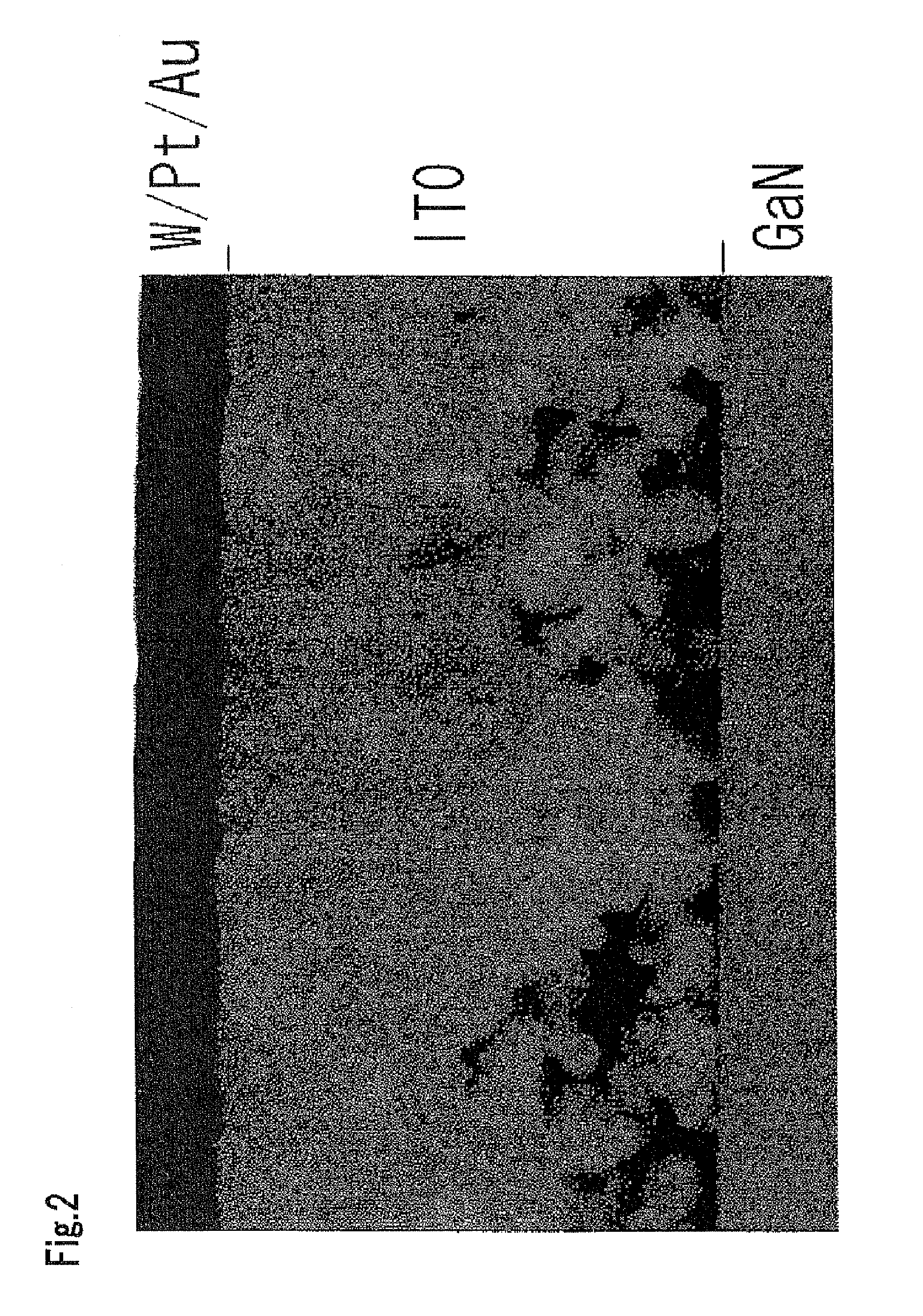Semiconductor light emitting element
a technology of light-emitting elements and semiconductor layers, which is applied in the direction of basic electric elements, semiconductor devices, electrical equipment, etc., can solve the problems of electrical energy conversion efficiency or light extraction efficiency decline, and the ohmic characteristics of semiconductor layers will not necessarily be good, so as to prevent a reduction in electrical power efficiency and energy consumption , the effect of superior ohmic characteristics
- Summary
- Abstract
- Description
- Claims
- Application Information
AI Technical Summary
Benefits of technology
Problems solved by technology
Method used
Image
Examples
example 1
[0114]A semiconductor light emitting element of this example is shown in FIG. 1.
[0115]The semiconductor light emitting element 10 is formed by laminating, in this order, onto a sapphire substrate 1, a buffer layer (not shown in the figures) composed of Al0.1Ga0.9N, and an undoped GaN (not shown in the figures). On top of that are laminated an n-type contact layer composed of Si doped GaN as an n-type semiconductor layer 2, and a superlattice n-type clad layer in which a GaN layer (40 Å) and a InGaN layer (20 Å) are alternately laminated 10 times. On top of that are laminated an active layer 3 having a multiquantum well structure in which a GaN layer (250 Å) and an InGaN layer (30 Å) are alternately laminated 3 to 6 times, a superlattice p-type clad layer as a p-type semiconductor layer 4 in which an Al0.1Ga0.9N layer doped with Mg (40 Å) and an InGaN layer doped with Mg (20 Å) are alternately laminated 10 times, and a p-type contact layer composed of GaN doped with Mg.
[0116]The acti...
example 2
[0145]The semiconductor light emitting element of this example has the same construction as that of Example 1, and is produced by substantially the same method as that of Example 1, except that when the ITO film is to be formed in the production method of Example 1, argon is initially employed as the sputter gas, and then is changed to a mixed gas of argon and oxygen.
[0146]Note also that when the sputter gas pressure during film formation is about 0.01 to 0.5 Pa, the partial pressure of the oxygen during film formation and thereafter is set to about 1×10−4 to 1×10−2 Pa. In addition, film formation is performed for about 20 minutes with argon, and then film formation is performed for about 5 minutes with the mixed gas of argon and oxygen.
[0147]With the semiconductor light emitting element thus obtaining, like with that of Example 1, the ohmic characteristics are excellent, transmissivity was good, light extraction efficiency will be increased, and the electrode side thereof will be m...
example 3
[0148]The semiconductor light emitting element of this example has substantially the same construction as that of Example 1, except that after the ITO film is formed in the production method of Example 1, or after a 5000 Å ITO film is formed while maintaining a constant RF power at room temperature in the production method of Example 1, lamp annealing is performed at, for example, 500 to 600° C. in a reducing gas atmosphere (e.g., a hydrogen gas atmosphere).
[0149]With the semiconductor light emitting element thus obtaining, like with that of Example 1, the ohmic characteristics are excellent, transmissivity is good, light extraction efficiency will be increased, and the electrode side thereof will be made into a light emission observation surface.
PUM
 Login to View More
Login to View More Abstract
Description
Claims
Application Information
 Login to View More
Login to View More - R&D
- Intellectual Property
- Life Sciences
- Materials
- Tech Scout
- Unparalleled Data Quality
- Higher Quality Content
- 60% Fewer Hallucinations
Browse by: Latest US Patents, China's latest patents, Technical Efficacy Thesaurus, Application Domain, Technology Topic, Popular Technical Reports.
© 2025 PatSnap. All rights reserved.Legal|Privacy policy|Modern Slavery Act Transparency Statement|Sitemap|About US| Contact US: help@patsnap.com



